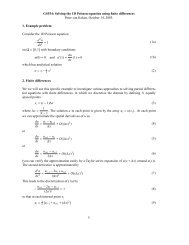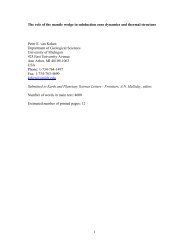Quantitative paleoenvironmental and paleoclimatic reconstruction ...
Quantitative paleoenvironmental and paleoclimatic reconstruction ...
Quantitative paleoenvironmental and paleoclimatic reconstruction ...
You also want an ePaper? Increase the reach of your titles
YUMPU automatically turns print PDFs into web optimized ePapers that Google loves.
ARTICLE IN PRESS<br />
N.D. Sheldon, N.J. Tabor / Earth-Science Reviews xxx (2009) xxx–xxx<br />
9<br />
For example, the large atomic radius alkali elements fit into different<br />
sites in minerals than the somewhat smaller alkaline earth elements.<br />
Observations of modern weathering of basalt parent soils suggest that<br />
the alkaline earth elements (which are also associated with more<br />
mafic minerals) weather more readily than the alkali elements<br />
(Chadwick et al., 1999), a pattern also observed in paleosols with a<br />
basaltic parent (see Section 5.3.1 for details; Sheldon, 2003; Tabor<br />
et al., 2004a; Sheldon, 2006c,d), though laterites formed on basalt do<br />
not necessarily conform to this rule of thumb (Hill et al., 2000).<br />
Elemental ratios are favoured over simple single-element measurements<br />
because the absolute abundance of an element within a soil/<br />
paleosol can vary dramatically over small spatial scales (e.g., between<br />
horizons), because the textural heterogeneity common in soils/<br />
paleosols can give rise to chemical heterogeneity, <strong>and</strong> because more<br />
process information is gained by looking at how two or more elements<br />
change with respect to one another.<br />
Examples of commonly applied major element ratios used to<br />
explain individual pedogenic processes are given in Table 3. Proxies for<br />
hydrolysis include ΣBases/Al (see Section 5.2.2) <strong>and</strong> Al/Si. Al/Si is<br />
thought to be a measure of “clayeyness” because Al accumulates in<br />
clay minerals relative to a silicate mineral parent. The ratio was first<br />
proposed (though inverted from the present form) by Ruxton (1968)<br />
<strong>and</strong> has been widely applied (various, e.g., Retallack et al., 2000;<br />
Prochnow et al., 2006; Sheldon, 2006b; Hamer et al., 2007b). Among<br />
the applications of the Al/Si ratio is the confirmation of field<br />
classification of Bt horizons (Sheldon, 2005; Hamer et al., 2007b)<br />
<strong>and</strong> as a measure of provenance (e.g., Sheldon, 2006a). The primary<br />
weakness of applying the Al/Si ratio is that it is difficult to account for<br />
syn-formational additions of Si due to aeolian processes, although by<br />
looking at a suite of elements that are also prone to windborne addition<br />
(i.e., other commonly occurring crustal elements; alternatively,<br />
with REE, see Ziegler et al., 2007), it is often possible to distinguish<br />
that process from pedogenic changes.<br />
The gleization ratio, Fe 2+ /Fe 3+ , is the most commonly applied<br />
major element ratio for underst<strong>and</strong>ing oxidation, though others have<br />
been proposed as well (see Retallack, 2001b for examples) based on<br />
Mn or on some combination of Fe <strong>and</strong> Mn. Gleization is sometimes<br />
used interchangeably with hydromorphism, <strong>and</strong> refers to the in situ<br />
reduction of Fe <strong>and</strong> Mn due to waterlogged conditions (Bockheim <strong>and</strong><br />
Gennadiyev, 2000). As with other major element ratios, it is important<br />
to consider the parent material chemical composition (e.g., Driese<br />
et al., 2003) because the initial, unweathered gleization ratio may be<br />
very different for different parent materials. For example, unweathered<br />
basalt will typically have a gleization ratio in excess of 2, whereas<br />
samples from well-drained paleosols derived from basalt will typically<br />
have gleization ratios much less than 0.5 (Sheldon, 2003) owing to<br />
oxidation during weathering. Sayyed <strong>and</strong> Hundekari (2006) found a<br />
similar pattern, with gleization ratios in unweathered basalts of 4–5,<br />
<strong>and</strong> values generally b1 for modern soils <strong>and</strong> paleosols derived from<br />
basalt. Driese (2004) also presented a similar result when comparing<br />
modern <strong>and</strong> Precambrian Vertisols. An additional application of the<br />
gleization ratio has been to look at redox changes across mass<br />
extinction events. In the earliest Triassic, southern hemisphere highpaleolatitude<br />
Gondwanan paleosols consistently show higher gleization<br />
ratios (i.e., more reduced conditions) than their latest Permian<br />
predecessors, coincident with Permian-Triassic extinction, <strong>and</strong> often<br />
over the space of cms (Retallack, 1999; Sheldon, 2006a). This has been<br />
interpreted to represent a very rapid (b10,000 year; Retallack <strong>and</strong><br />
Jahren, 2008) shift to highly reducing soil gas conditions. Given that<br />
paleosols above <strong>and</strong> below the boundary represent wetl<strong>and</strong> settings<br />
(which should be fairly reduced anyway), this change is striking<br />
(Sheldon, 2006a). The primary weakness of applying the gleization<br />
ratio is one of constraining the timing of the reduction of Fe 3+ to Fe 2+ ,<br />
because groundwater movement during early diagenesis (i.e., typically<br />
reducing waters) or exposure of the paleosol profiles to oxidizing<br />
waters during uplift <strong>and</strong> exposure could, theoretically at least, change<br />
the ratio. Ways to account for this possibility include careful<br />
characterization of the Fe-bearing minerals using petrography, SEM,<br />
or microprobe analysis, field observations of redoximorphic features<br />
in the paleosol (Kraus <strong>and</strong> Aslan, 1993), <strong>and</strong> mass-balance calculations<br />
(see Section 5.3.1 for details) of both redox-sensitive <strong>and</strong> redoxinsensitive<br />
elements to look for evidence of diagenetic changes.<br />
Salinization (Table 3) is the process by which otherwise mobile<br />
elements (K <strong>and</strong> Na) accumulate as soluble salts in a soil or paleosol.<br />
Examples of this process can be found fairly commonly in modern<br />
(e.g., Buck et al., 2006), Cenozoic (e.g., Hartley <strong>and</strong> May, 1998), <strong>and</strong><br />
Mesozoic (e.g., Lawton <strong>and</strong> Buck, 2006) soils <strong>and</strong> paleosols that form<br />
in arid regions or deserts. Older examples are much more rare because<br />
salts are often removed by diagenesis, leaving evaporite mineral<br />
pseudomorphs rather than the original minerals. The salinization ratio<br />
may also be related to mean annual temperature in some settings (see<br />
Section 5.4; Sheldon et al., 2002), <strong>and</strong> though other ratios have been<br />
proposed (see Retallack, 2001a,b), only this one has been widely<br />
applied. However, salinization is not one of the most reliable<br />
pedogenic process indicators because of differences in behaviour<br />
between in K <strong>and</strong> Na during pedogenesis. In general, Na is less subject<br />
to diagenetic redistribution (Retallack, 1991). To verify salinization<br />
results, investigators should also look for other aridity indicators such<br />
as pedogenic carbonate nodules <strong>and</strong> physical presence of evaporite<br />
minerals in h<strong>and</strong> specimen or thin section.<br />
Leaching may be quantified in paleosols using a base loss ratio<br />
where the abundance of a given base is divided by the abundance of Ti.<br />
This approach, though simple, bypasses the problem associated<br />
with full mass-balance calculations of needing to measure or estimate<br />
bulk density values for paleosol <strong>and</strong> parent material samples (see<br />
Section 5.3). In particular, it may be valuable for paleosols recovered<br />
from deep drilling cores where there is a limited amount of material<br />
available <strong>and</strong> using some of it for bulk density measurements (which<br />
are effectively destructive if the clod-paraffin method is used) is not<br />
possible (Sheldon, 2006c). The keys to using base loss ratios are that<br />
they must be plotted as a function of depth because different horizons<br />
should show different elemental behaviour, <strong>and</strong> that multiple<br />
elements need to be plotted, included both alkali <strong>and</strong> alkaline earth<br />
elements to capture the full range of pedogenic processes. P/Ti may<br />
also be plotted as a rough guide to paleo-fertility. This approach has<br />
been applied to basalt-parented paleosols thus far (Tabor et al., 2004a;<br />
Sheldon, 2006c), but should in theory, be widely applicable. The<br />
primary potential problem with this approach is with low-Ti parent<br />
materials, because then relatively minor differences in Ti content<br />
could show apparently large differences in pedogenesis. Thus, this<br />
approach to quantifying leaching works best for paleosols that have<br />
igneous or metamorphic parent materials, <strong>and</strong> less well for paleosols<br />
that formed on limestone or relatively quartz-rich parent materials.<br />
The Ti/Al ratio is particularly useful as a provenance indicator<br />
because Ti contents may be quite variable among different types of<br />
rocks, even as Al contents are relatively constant (e.g., granite vs.<br />
basalt; Li, 2000). In general, the more mafic the parent material, the<br />
higher the Ti/Al ratio will be (Fig. 6; Maynard, 1992). Furthermore,<br />
because both elements are relatively immobile, the ratio should<br />
remain constant during pedogenesis at near-neutral pHs (5.5–8), <strong>and</strong><br />
should also be constant as a function of depth within a paleosol<br />
(Sheldon, 2006a). At near-neutral conditions, Al is slightly more<br />
mobile than Ti (Li, 2000), <strong>and</strong> Al can be mobilized significantly in<br />
older soils (e.g., N150 Ka, Kurtz et al., 2000). Ti <strong>and</strong> Al are most mobile<br />
under acidic pH conditions, so the ratio should also potentially shift<br />
from the parent material value according to the pH at the time of<br />
formation. Neither element is redistributed readily by diagenesis, so<br />
the Ti/Al ratio should be a reliable indicator of provenance even for<br />
Precambrian paleosols if they formed at near neutral pH conditions<br />
<strong>and</strong> had short to moderate (b100 Ka) formation times, though<br />
potentially, it also may be used as paleo-weathering intensity<br />
measurement in paleosols that do not exhibit constant values with<br />
Please cite this article as: Sheldon, N.D., Tabor, N.J., <strong>Quantitative</strong> <strong>paleoenvironmental</strong> <strong>and</strong> <strong>paleoclimatic</strong> <strong>reconstruction</strong> using paleosols, Earth-<br />
Science Reviews (2009), doi:10.1016/j.earscirev.2009.03.004















